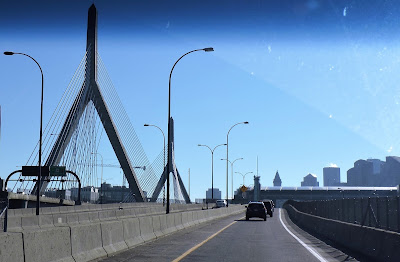First of all, what does the "U.S.S" stand for? United States Ship, of course! Just like H.M.S. stands for Her Majesty's Ship.
The
U.S.S. Constitution ...
was ordered to be built by George Washington - and is the
oldest commissioned warship
in the world. Launched in 1797 with a crew of 400 men and boys, she got her nickname during the War of 1812 when she and her crew defeated four (count them, f-o-u-r) British frigates!
Now, you ask, what's a frigate? Well, in 1812 it was
a square-rigged war vessel intermediate between a corvette and a ship of the line. No, no. Not that kind of corvette! A corvette in sailor's terms was a ship that had a flush deck and usually one tier of guns. Corvette's were sleek and fast, which is probably why Chevy chose that name for their muscle-car. A ship of the line, however, was slow and heavy. It was square-rigged warship having at least two, and as many as four, gun decks and designed to be positioned for battle in a
line with other such
ships, hence the name.

How, might you ask, did one ship defeat four? Well, though the
Constitution was made of oak, it was America's live oak, Quercus virginiana. Yeah, so? Well, American trees were a lot older than anything in England - or any where else in Europe - because no one had been cutting them down wholesale for centuries to build ships and war machines and castles. What Europeans were using were relatively young trees. You might say America's oak was aged - and it
is incredibly dense, and rot-resistant. Anyway, the oak in the
Constitution's hull was so hard that the English cannonballs just bounced off of her sides! The nickname
Old Ironsides has stuck with her all of these years.
Though the Latin name implies the timber came from Virginia,
Old Ironsides' timbers actually came from the swampy shores of Georgia. (I'll bet our pastor from Kaua'i, who is a native of Georgia, will like this...) The shipbuilders sailed to Georgia with 80 New England axemen to chop down the timbers needed to build the frigates that George Washington ordered. Those hard-as-nail live oak trees along with the heat, humidity and mosquitoes either killed those New Englanders or sent them scampering back north! Only a total of four of those Yankees managed to survive to the end of the job. Most of the timber was harvested by slaves provided by local families. (We've learned the hard way that cutting down live oak trees in East Texas will ruin a good chainsaw in no time at all. Can you imagine how hard it was back in the 1700's to fell a live oak tree using an
axe!)

So, what does it mean to be commissioned? She's not a floating museum; she's still a warship with sailors assigned tours of duty aboard her, and, when she's not in dry dock, they sail her!
For the near future, however,
Old Ironsides is in dry-dock. Her copper hull is being replaced, among other things, and this sailor (assigned to the crew - at his request!) is manning a table of the copper plates that will be used. With a special stylus, he is encouraging visitors to sign their names. So, Granpa and I signed, and our names will be attached to the bottom of the oldest commissioned warship
in the world. That's kinda cool!
Today, she sails with a whole lot less than the 400 originally assigned. She probably won't be doing any battle, but when she did back in the day, her captain signed on 30 boys to carry gunpowder to the gunners during battle. Fifty of the men were marines serving as sentries. She also had probably 10% of her crew made up of black Americans. ( I confess, looking back there are a whole lot of jobs I'd like to have tried my hand at - but sailing is definitely, unequivocally NOT one of them. Just
thinking about it makes me seasick! But I'm mighty proud of the sailors who have taken to the seas to defend America around the globe!)













































